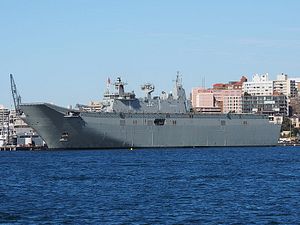Is Australia going to take another look at the F-35B? Specifically, will Australia reconsider the acquisition of the F-35B for its Canberra-class amphibious assault ships?
Perhaps inevitably, Japan’s decision to modify its Izumo-class aircraft carriers to operate the F-35B has rekindled debate over the ships in Australia. For reasons good and ill, military procurement decisions often have a transnational impact; civilians and soldiers feel the need to match their friends as well as their enemies, and big acquisitions can change the symbolic landscape that military organizations operate in. The Japanese decision also has more practical consequences, as it increases the interoperability returns for an Australian acquisition, and may marginally reduce the cost of buying the F-35B. Indeed, in light of the British decision to fly F-35Bs from its two large carriers, almost all of Australia’s major defense partners will field carrier-borne F-35Bs. As was the case with Japan, the Royal Australian Navy almost certainly can rely on the theoretical and practical work that the U.S. Marine Corps has done on optimizing the effectiveness of the F-35B on its own large amphibious assault ships.
The Canberras were and weren’t designed to fly the F-35B. Based on the Spanish Juan Carlos I, the 27,000 ton Canberras can make 21 knots and sport a ski-jump flight deck. One officer reportedly quipped that he wished the ski-jumps on the ships could be demolished in order to dissuade the government from acquiring F-35Bs. Although Juan Carlos is designed as a light aircraft carrier, the Canberras were built around an amphibious mission that leaves them superficially similar to their half-sister, but less capable of flying modern fighter aircraft. Turkey has also acquired a Juan Carlos variant, although political problems may preclude it from buying the F-35B.
Australia is already buying the F-35A. And Australia could probably use the F-35B in a variety of non-carrier contingencies, as it can take-off from under-prepared airfields across Southeast Asia. The government has resisted investing in the F-35B, however. Inter-service rivalry plays a role here, as the Royal Australian Air Force has been noticeably cold about acquiring a capability that would result in a division of offensive air responsibilities.
Australia faces many of the same dilemmas as Japan; it acquired amphibious warships to conduct amphibious warfare and its ancillary operations, such as humanitarian assistance and disaster relief. Indeed, in outlining the difficulties in modifying the Canberras, and the trade-offs associated with giving up a portion of their amphibious capabilities, Malcolm Davis suggests acquiring another one or two carriers. But then, Australia has a fifth of the population of Japan and a quarter of the GDP. While Australia has operated carriers before, its navy is distinctly second tier, while Japan can build whatever sort of navy it requires. Much will depend on how independent of a foreign policy Australia wants to sketch out over the next decades, and how much Canberra is willing to invest in that sketch.
The views expressed here are his personal views and do not necessarily reflect those of the Department of Defense, the U.S. Army, the Army War College, or any other department or agency of the U.S. government.

































